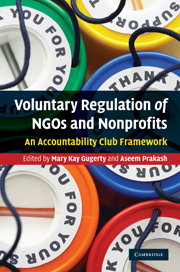Book contents
- Frontmatter
- Contents
- List of figures
- List of tables
- Notes on contributors
- Preface
- The club framework
- Part I Club emergence
- Part II Club sponsorship and club design
- 5 Nonprofit infrastructure associations as reluctant clubs
- 6 Foundation accountability clubs and the search for philanthropic standards
- 7 Do self-regulation clubs work? Some evidence from Europe and some caveats from economic theory
- 8 NGO accountability clubs in the humanitarian sector: social dimensions of club emergence and design
- Part III Club design and effectiveness
- Future research and conclusions
- Index
- References
6 - Foundation accountability clubs and the search for philanthropic standards
from Part II - Club sponsorship and club design
Published online by Cambridge University Press: 10 November 2010
- Frontmatter
- Contents
- List of figures
- List of tables
- Notes on contributors
- Preface
- The club framework
- Part I Club emergence
- Part II Club sponsorship and club design
- 5 Nonprofit infrastructure associations as reluctant clubs
- 6 Foundation accountability clubs and the search for philanthropic standards
- 7 Do self-regulation clubs work? Some evidence from Europe and some caveats from economic theory
- 8 NGO accountability clubs in the humanitarian sector: social dimensions of club emergence and design
- Part III Club design and effectiveness
- Future research and conclusions
- Index
- References
Summary
Today, private foundations in the United States number more than 68,000, control $500 billion in assets, and make grants totaling more than $20 billion annually. Foundations often provide critical early capital to nonprofit organizations seeking to start new programs or projects. By virtue of their wealth and influence in the broader nonprofit sector, foundations have long occupied a privileged position and tend to be treated with deference not just by the organizations that depend on their grants, but by government which recognizes the significance of these private funds directed at solving public needs. In many of the chapters in this volume, foundations play the role of principal, making accountability claims on their grantees. This chapter examines how accountability issues play out when foundations themselves face their own set of accountability claims.
Accountability issues in the foundation field differ in a number of ways from those facing nongranting nonprofits. A key concern of nonprofit organizations is securing the financial resources needed to carry out their programs. Thus donor organizations tend to be important nonprofit principals. Foundations are grantmaking organizations with their own endowments and are resource independent. The accountability claims on foundations differ from those made on other kinds of charitable organizations because of this independence. Foundations are more insulated from accountability claims from the public at large because they are not directly using public funds to carry out their programs.
- Type
- Chapter
- Information
- Voluntary Regulation of NGOs and NonprofitsAn Accountability Club Framework, pp. 125 - 151Publisher: Cambridge University PressPrint publication year: 2010
References
- 1
- Cited by



